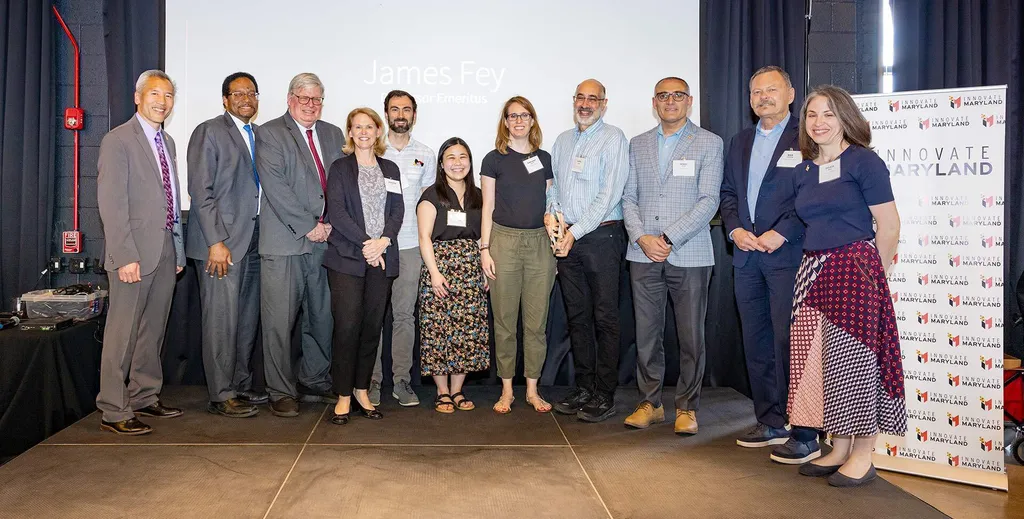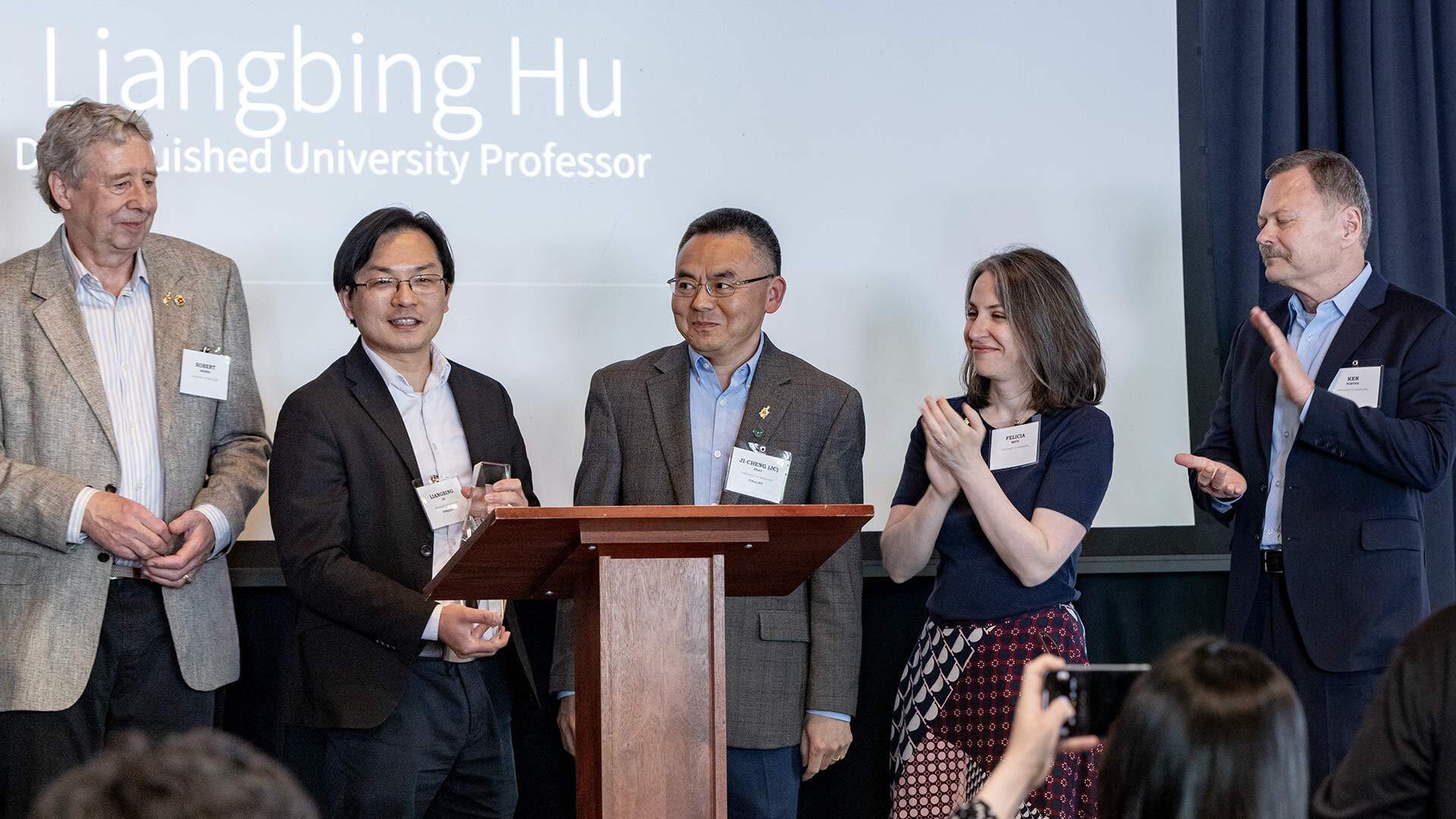- April 30, 2024
- By Jordan Dunklee
In a mesmerizing display, a kaleidoscope of tiny lightning strikes gives way to a brilliant glow hotter than the surface of the sun. While this spectacle may sound like a scene from a sci-fi blockbuster, it’s happening not in a film studio, but in a University of Maryland laboratory.
That miniature lightning is electric arcs passing between two “hairy”-looking blocks made up of carbon fibers; the glow is a plasma that reaches 8,000 degrees Celsius—nearly twice as hot as the highest melting point of any metal. But it isn’t just ultra-hot; it’s also stable enough to revolutionize high-temperature materials engineering. The method took home the top prize Monday in the university’s annual Invention of the Year competition.
"Our simple and practical ultra-high temperature plasma technology overcomes the challenges we've seen with producing extreme materials and opens the door to large-scale manufacturing powered by renewable energy, but with low cost and high benefit to the planet,” said Distinguished University Professor Liangbing Hu, the project’s principal investigator.
Along with winners in three other categories, the award was announced as part of Innovate Maryland—an annual celebration of UMD researchers’ creativity in translating cutting-edge research into practical, impactful solutions to address global challenges.
“Each of tonight’s nominees for Invention of the Year started with that spark of an idea that was allowed to grow and evolve with the help of our robust research enterprise, which we all contribute to and improve on a daily basis,” Vice President for Research Gregory F. Ball said of this year’s 12 finalists. “I firmly believe that no grand challenge is too daunting for our world-class researchers to confront head-on and work toward a solution.”
In addition to the Invention of the Year awards, two faculty innovators received special recognition awards for their significant contributions to UMD’s innovation ecosystem and for making a lasting impact in the region and beyond:
- President Darryll J. Pines presented a special recognition award to Hu, a professor in the Department of Materials Science and Engineering. Hu has submitted 134 invention disclosures, making him the second-most prolific inventor in the university’s history—a feat he accomplished in only 11 years. He also co-founded the highest number of university IP-based startups, with a record four this fiscal year alone.
- Senior Vice President and Provost Jennifer King Rice presented a special recognition award to James Fey, a professor emeritus in the College of Education’s Center for Math Education. Fey co-authored a series of children’s mathematics workbooks and curricula that have generated $4.1 million in revenue for UMD since 1991. Fey donated his share of the royalties back to the department to fund over a dozen PhD students in the Fey-Graeber Fellowship program.

“We’re especially pleased this year to add the special recognition awards for Professor Bing Hu and Professor Emeritus Jim Fey,” said Dean Chang, the university’s chief innovation officer. “Bing has an unparalleled track record of innovation that reaches far beyond our campus, and Jim’s copyrighted and trademarked curricula is a wonderful example of how the UMD UM Ventures team can turn creative works into inclusive economic and societal impact. Tech transfer is not just about science and technology patents.”
Here are the 2024 Invention of the Year Award winners across all categories:
Physical Sciences Invention of the Year/Overall Winner: Stable Plasma for Extreme Materials
Department of Materials Science and Engineering researchers Liangbing Hu, Hua Xie, Qian Zhang and Ji-Cheng Zhao and Princeton University researcher Yiguang Ju have developed a new method for creating stable plasma that can be used in extreme materials. The protocol works by applying a voltage between two blocks made of thin carbon fibers. The fibers act as a tip through which electrons can flow, resulting in all the gas between the blocks being turned into a highly stable and ultra high-temperature plasma. The process is simple, scalable and powered by renewable energy, allowing for reduced cost and a lower carbon footprint to make extreme materials.
Information Sciences Invention of the Year: Binoculars: A Method for Detecting Text Generated by Large Language Models
Two years ago, the launch of ChatGPT kicked off an AI boom that has been making headlines ever since. The growth of AI—specifically of large language models (LLMs) like ChatGPT—has been felt across all industries, but raises concerns about plagiarism, fraud and disinformation. Recent attempts to detect LLM-generated content have been consistently found unreliable, but College of Computer, Mathematical, and Natural Sciences researchers Tom Goldstein, a Volpi-Cupal Family Endowed Professor in the Department of Computer Science, and Abhimanyu Hans ’25, as well as Avi Schwarzschild Ph.D. ’23, now of Carnegie Mellon University, have developed an accurate method for distinguishing human-generated content.
The method, dubbed “Binoculars,” does not require any training data and does not need to modify the LLM to detect AI-generated text. It is also more reliable than many of its predecessors, with an accuracy rate of 90% and a false positive rate of 0.01%.
Life Sciences Invention of the Year: Combination Therapy and Diagnostic Tool for Aggressive Prostate Cancer
Each year, about 300,000 new cases of prostate cancer are diagnosed in the United States, affecting one in eight men during their lifetimes; one in 44 will eventually succumb to the disease. This grim reality is amplified among African American men, who experience an incidence rate 2.3 times higher and mortality rate 1.7 times higher than their white counterparts. Research has attributed this disparity to a blend of socioeconomic factors and biological vulnerabilities, underscoring the urgent need for targeted interventions.
Associate Professor Bi-Dar “Peter” Wang and Visiting Scientist Mohammad Waseem from the University of Maryland Eastern Shore have identified a precision prognostic biomarker and therapeutic tool, specifically for African American men. The novel treatment method combines gene therapy, introducing a tumor-suppressing mimic gene, with androgen receptor antagonists, drugs that stop the growth and spread of cancer cells. The method shows promise in treating prostate cancer that has become resistant to other types of therapy, and could potentially be used to treat all forms of advanced prostate cancer.
Quantum Invention of the Year: Quantum Non-Demolition Photon Counter
The rise of quantum computing presents unprecedented opportunities, leveraging the laws of quantum mechanics to tackle challenges beyond classical computers’ reach. Challenges to quantum computing have led researchers around the world to turn to the use of photons, or tiny particles of light, that can carry information from one place to another. With this development, photon counting has become a vital part of the field.
Traditional methods of photon counting destroy the particles’ quantum states, and existing attempts to circumvent this have a number of limitations. Researchers in the Department of Physics and the National Institute of Standards and Technology—NIST physicist and Adjunct Professor Alexey Gorshkov, NIST physicist and Adjunct Assistant Professor Michael Gullans, NIST Research Scientist James “Trey” V. Porto, graduate student Christopher Fechisin, current IBM Research Scientist Kunal Sharma, current Amazon Web Services Research Scientist Przemyslaw Bienias and Department of Physics Chair Steven Rolston have developed a new protocol that eliminates these limitations. Unlike previous methods, the researchers’ protocol has no fundamental limitation on the number of photons being counted and has the ability to count itinerant—or moving—photons. Their work has potential applications in light detection and ranging (LIDAR), fiber optic communication, quantum information processing, quantum encryption and cybersecurity, medical imaging, DNA sequencing and astrophysics.
Read the full list of finalists in every category.
